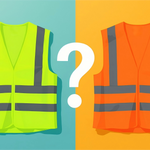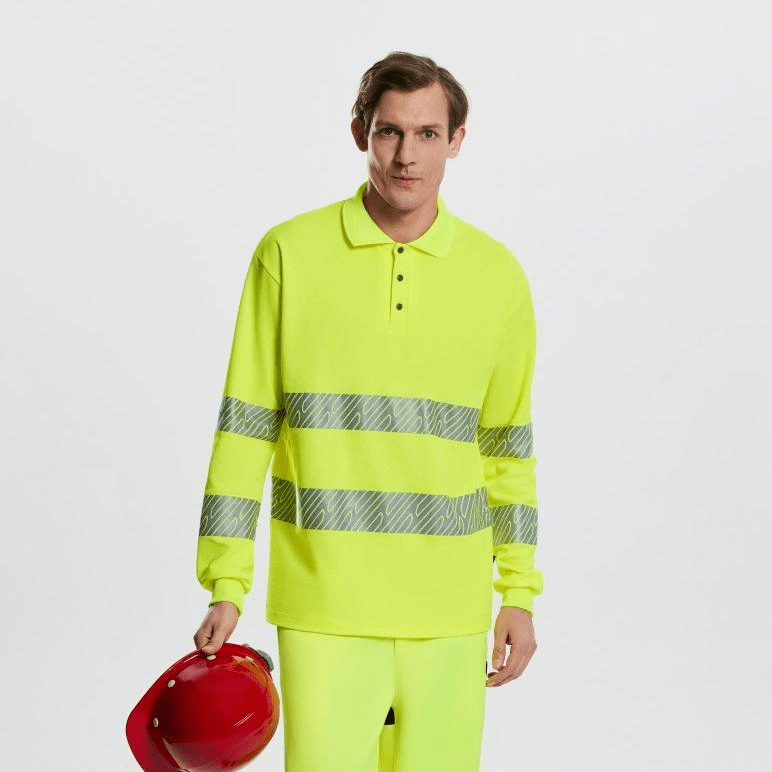
Hi-Vis-Arbeitsbekleidung in begrenzten Räumen: Eine europäische Sicherheitsperspektive
Warnschutzkleidung (Hi-Vis) ist für die Sicherheit der Arbeiter in engen Räumen in Europa unerlässlich. Von Tunneln und unterirdischen Gewölben bis hin zu Abwasserkanälen und Lagertanks sorgt EN ISO 20471-zertifizierte Kleidung für Sichtbarkeit, während EN 343-zertifizierte Regenbekleidung vor Nässe schützt. Dieser Leitfaden untersucht wichtige Sicherheitsfaktoren wie schlechte Lichtverhältnisse, Hängenbleiben-Gefahr, extreme Temperaturen und die Integration von PSA.
22 August 2025
Aktie
Warnschutzkleidung ist nicht nur für Straßenarbeiter wichtig – sie ist auf Baustellen in ganz Europa ebenso wichtig, da die Arbeiter Fahrzeugen, beweglichen Maschinen oder komplexen Umgebungen ausgesetzt sind. Dazu gehören enge Räume wie Tunnel, unterirdische Baustellen, Abwasserkanäle, Schächte, Lagertanks, Silos, Pipelines, Gräben, Schiffsrümpfe, Laderäume, Kesselräume, Klimakanäle, Bergwerke, Steinbrüche, Versorgungsschächte oder Umspannwerke.
Inhalt:
- Warnschutzkleidung in engen Räumen: Eine europäische Sicherheitsperspektive
- Umgebungen mit wenig Licht
- Brand- und Stromgefahren
- Gefahren durch Hängenbleiben
- Wetter- und Temperaturextreme
- PSA-Integration
- Abschluss
Die Notwendigkeit von Warnschutzkleidung in engen Räumen hängt von den individuellen Risiken des jeweiligen Standorts ab. Befindet sich ein enger Raum in der Nähe von aktiven Maschinen, Fahrzeugen oder Baustellen, Warnschutz-Arbeitskleidung zertifiziert nach EN ISO 20471 wird zu einer wesentlichen Schutzschicht gegen Unfälle. Nachfolgend finden Sie die wichtigsten Sicherheitsaspekte bei der Bewertung von Sichtbarkeits- und Schutzkleidung für Arbeiter in engen Räumen in ganz Europa.
Umgebungen mit wenig Licht
Enge Räume sind oft schlecht beleuchtet oder völlig dunkel, sodass künstliche Beleuchtung wie Stirnlampen oder tragbare Scheinwerfer erforderlich ist. Selbst unter diesen Bedingungen reflektierende Materialien auf Warnschutz-Arbeitskleidung verbessern die Sichtbarkeit bei Beleuchtung durch künstliche Lichtquellen.
In Situationen ohne jegliche Beleuchtung, in denen Arbeiter isoliert von fahrenden Fahrzeugen oder Maschinen arbeiten, ist Warnschutzkleidung möglicherweise nicht der wichtigste Sicherheitsfaktor. Stattdessen im Dunkeln leuchtende oder nachleuchtende Elemente können herkömmliche Reflektorbänder ergänzen und in Notfällen für Sichtbarkeit sorgen. Obwohl sie nach europäischen Normen nicht vorgeschrieben sind, können sie für zusätzliche Sicherheit sorgen.
Brand- und Stromgefahren
Einige enge Räume enthalten brennbare Gase, Dämpfe oder elektrische Geräte. In solchen Fällen reicht normale Warnschutzkleidung nicht aus. Arbeiter sollten speziell entwickelte Schutzkleidung das sowohl sichtbar als auch feuerbeständig ist.
Für die meisten Baustellen bleibt die Priorität EN ISO 20471-zertifizierte Warnschutzkleidung für Sichtbarkeit. Bei Brand- oder Elektrizitätsgefahren müssen Arbeitgeber zusätzlich geeignete PSA mit Flammschutz tragen und die Einhaltung der europäischen Sicherheitsrichtlinien gewährleisten.
Gefahren durch Hängenbleiben
In engen, geschlossenen Räumen besteht ein hohes Risiko, dass Kleidung an Rohren, scharfen Kanten oder Maschinen hängen bleibt. Ein Hängenbleiben kann zu Einklemmen, Stürzen oder sogar Strangulation führen, wenn Fluchtwege eingeschränkt sind. So vermeiden Sie dies:
- Arbeiter sollten tragen optimierte Warnschutz-Arbeitskleidung mit minimal losem Stoff gestaltet.
- Abreißbare Warnwesten sind besonders nützlich bei Arbeiten in engen Räumen, da sie im Notfall eine schnelle Freigabe ermöglichen.
- Eng anliegende Warnhemden verringern die Gefahr, sich zu verfangen.
Vor der Einreise sind europäische Arbeitgeber gesetzlich verpflichtet, EU-PSA-Richtlinie (89/656/EWG) eine Gefahrenbewertung durchzuführen und für die Umgebung geeignete PSA auszuwählen.
Wetter- und Temperaturextreme
Die Sicherheit in engen Räumen in Europa überschneidet sich oft mit herausfordernde Wetterbedingungen — insbesondere Regen und Feuchtigkeit auf Baustellen unter Tage oder im Freien.
- Regen und Feuchtigkeit: In engen Räumen, die nassen Umgebungen ausgesetzt sind, sollten Arbeiter Regenkleidung tragen, die EN 343, der europäische Standard für wasserdichte und atmungsaktive Schutzkleidung.EN 343-zertifizierte Warnschutz-Regenjacken und -hosen gewährleisten sowohl Wetterschutz als auch Sichtbarkeit, indem sie das Eindringen von Wasser verhindern und gleichzeitig die Verdunstung von Schweiß ermöglichen.
- Heiße Bedingungen: In Tunneln oder Kesselräumen sind die Arbeiter Hitzestress ausgesetzt. Leicht, atmungsaktiv Warnschutz-T-Shirts oder Poloshirts Die nach EN ISO 20471 zertifizierten Schutzbrillen tragen dazu bei, Überhitzung zu reduzieren und gleichzeitig die Sicht zu erhalten.
- Kalte Bedingungen: Im Winter oder in unterirdischen Gewölben, isoliert und wasserdicht Warnwesten bieten Wärme und sorgen gleichzeitig für Flexibilität und Sichtbarkeit. Das Tragen von Thermo-Basisschichten verhindert Kältestress.
Durch Auswahl saisongerechte Warnschutzkleidung, bleiben die Arbeiter in verschiedenen Umgebungen sicher, trocken und sichtbar.
PSA-Integration
Bei Arbeiten in engen Räumen in Europa ist häufig die Kombination von Warnschutzkleidung mit zusätzlicher persönlicher Schutzausrüstung wie Auffanggurten, chemikalienbeständigen Anzügen, Atemschutzmasken, Schutzhelmen und Handschuhen erforderlich. Damit Warnschutzkleidung ihre Wirksamkeit behält, muss sie sich nahtlos in diese Ausrüstung integrieren lassen.
Zum Beispiel:
- Warnwesten sollte über Gurte passen, ohne die Reflektorstreifen zu verdecken.
- Feuchtigkeitsableitende Warnschutzhemden sollte unter Schutzoveralls bequem bleiben.
Gutes Design sorgt dafür, dass Sichtbarkeitsanforderungen nach EN ISO 20471 bleiben intakt, während die Arbeiter zusätzliche PSA verwenden.

Abschluss
Warnschutzkleidung ist in engen Räumen in ganz Europa nicht immer vorgeschrieben, bietet aber in vielen Fällen eine kritische Sicherheitsebene — insbesondere wenn Fahrzeuge, bewegliche Maschinen oder die Koordination von Teams im Spiel sind. Durch die Kombination EN ISO 20471-zertifizierte Warnschutzkleidung mit zusätzlichen Schutzstandards wie EN 343 für Regenbekleidungkönnen Arbeitgeber ihren gesetzlichen Verpflichtungen nachkommen, EU-PSA-Richtlinie und gleichzeitig die Risiken für die Arbeitnehmer deutlich zu reduzieren.
Jeder enge Raum muss einer standortspezifischen Risikobewertung unterzogen werden. Auf dieser Grundlage sollten Arbeitgeber Warnschutzkleidung auswählen, die nicht nur die Einhaltung der Vorschriften gewährleistet, sondern auch Komfort, Mobilität und das Selbstvertrauen der Mitarbeiter erhöht. Letztendlich geht es bei Sichtbarkeit nicht nur darum, gesehen zu werden – es geht um Sicherheit.
Vorheriger Beitrag

Die Psychologie und Wissenschaft von Hi-Vis-Farben: Warum werden Gelb und Orange am meisten verwendet?
Aktualisiert am 29 August 2025
Nächster Beitrag

Von den 3.000 Todesfällen von 2022 bis heute - die anhaltende Sicherheitsherausforderung der EU
Aktualisiert am 15 August 2025



